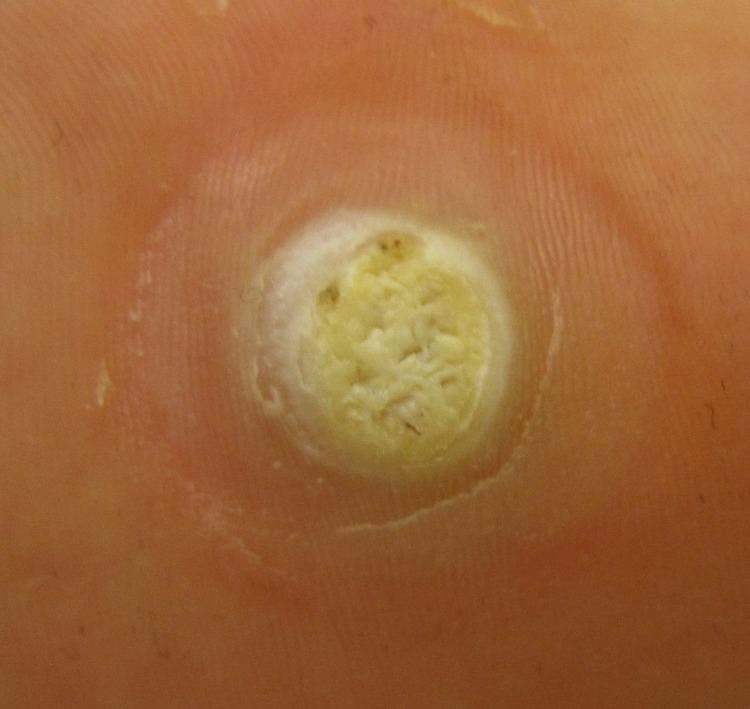ICD-9-CM 078.12 | ICD-10 B07 | |
 | ||
Synonyms verruca, myrmecia, verruca plantaris | ||
A plantar wart is a wart occurring on the sole or toes of the foot. They are caused by the human papillomavirus (HPV). HPV infections in other locations are not plantar warts.
Contents
Plantar warts are usually self-limiting, but treatment is generally recommended to lessen symptoms (which may include pain), decrease duration, and reduce transmission. Infection occurs in an estimated 7–10% of the US population, and genetics plays an important role in determining susceptibility.
Cause
Plantar warts are benign epithelial tumors generally caused by infection by human papilloma virus types 1, 2, 4, 60, or 63, but have also been caused by types 57, 65, 66, and 156. These types are classified as clinical (visible symptoms). The virus attacks compromised skin through direct contact, entering through possibly tiny cuts and abrasions in the stratum corneum (outermost layer of skin). After infection, warts may not become visible for several weeks or months. Because of pressure on the sole of the foot or finger, the wart is pushed inward and a layer of hard skin may form over the wart. A plantar wart can be painful if left untreated.
Warts may spread through autoinoculation, by infecting nearby skin or by infected walking surfaces. They may fuse or develop into clusters called mosaic warts.
Diagnosis
A plantar wart is a small lesion that appears on the surface of the skin and typically resembles a cauliflower, with tiny black petechiae (tiny hemorrhages under the skin) in the center. Pinpoint bleeding may occur when these are scratched. Plantar warts occur on the soles of feet and toes. They may be painful when standing or walking.
Plantar warts are often similar to calluses or corns, but can be differentiated by close observation of skin striations. Feet are covered in skin striae, which are akin to fingerprints on the feet. Skin striae go around plantar warts; if the lesion is not a plantar wart, the striations continue across the top layer of the skin. Plantar warts tend to be painful on application of pressure from either side of the lesion rather than direct pressure, unlike calluses (which tend to be painful on direct pressure instead).
Prevention
Human papillomavirus (HPV) is spread by direct and indirect contact from an infected host. Avoiding direct contact with infected surfaces such as communal changing rooms and shower floors and benches, avoiding sharing of shoes and socks and avoiding contact with warts on other parts of the body and on the bodies of others may help reduce the spread of infection. Infection is less common among adults than children.
As all warts are contagious, precautions should be taken to avoid spreading them. The British National Health Service recommends that children with warts:
Plantar warts are not prevented by inoculation with currently available HPV vaccines because the warts are caused by different strains of HPV. Gardasil protects against strains 6, 11, 16, and 18, and Cervarix protects against 16 and 18, whereas plantar warts are caused by strains 1, 2, 4, and 63.
Treatment
A number of treatments have been found to be effective. A 2012 review of different treatments for skin warts in otherwise healthy people concluded modest benefit from salicylic acid and cryotherapy appears similar to salicylic acid.
Medications
Salicylic acid — The treatment of warts by keratolysis involves the peeling away of dead surface skin cells with keratolytic chemicals such as salicylic acid or trichloroacetic acid. These are available in over-the-counter products or, in higher concentrations, may need to be prescribed by a physician. A 12-week daily treatment with salicylic acid has been shown to lead to a complete clearance of warts in 10–15% of the cases.
Formic acid — Topical formic acid is a common treatment for plantar warts, which works by being applied over a period of time causing the body to reject the wart.
Immunotherapy — Intralesional injection of antigens (mumps, candida or trichophytin antigens USP) is a new wart treatment which may trigger a host immune response to the wart virus, resulting in wart resolution. It is now recommended as a second-line therapy.
Surgery
Liquid nitrogen — This, and similar cryosurgery methods, is a common surgical treatment which acts by freezing the external cell structure of the warts, destroying the live tissue. Up to three sessions may be required.
Electrodesiccation and surgical excision, which may produce scarring.
Laser surgery — This is generally a last resort treatment, as it is expensive and painful, but may be necessary for large, hard-to-cure warts.
Cauterization — This may be effective as a prolonged treatment. As a short-term treatment, cauterization of the base with anesthetic can be effective, but this method risks scars or keloids. Subsequent surgical removal is unnecessary, and risks keloids and recurrence in the operative scar.
